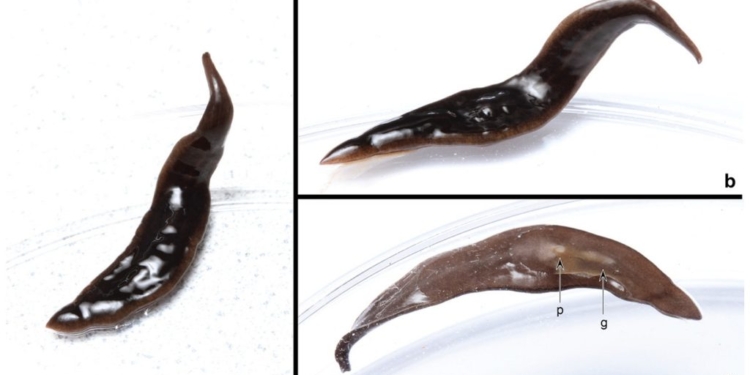
Posted on 09/25/2024 8:56:27 PM PDT by Red Badger

A living Amaga Pseudobama specimen in a petri dish, observed from three different views. © Justine, et al/PeerJ
Scientists have discovered a never-before-seen invasive species of land flatworm living in North Carolina, Florida, and possibly other parts of the U.S.
The United States appears to be playing host to a novel wormy invader. In a new study this week, scientists report on the discovery of a never-before-seen species of flatworm living in North Carolina, Georgia, Florida, and possibly other parts of the U.S. The predatory worm likely originated from South America and closely resembles other invasive species, which will hamper efforts to track its presence in the U.S., the researchers say.
The new worm—named Amaga pseudobama—is a type of terrestrial, or land, flatworm. These worms tend to natively live in tropical environments closer to the equator, making the discovery of this species in the U.S. both interesting and potentially concerning. Non-native, or invasive, species can often throw off the balance of an ecosystem by outcompeting native animals in the same niche or by consuming precious resources. At this point, though, much about the newly discovered worms remains unknown.
“It has not been observed in the wild or native habitats, so we don’t know much about how it interacts with its environment. We can infer from what we know about related species, but we don’t know precisely what it preys on, how quickly it reproduces, and so on,” said Matt Bertone, a researcher from North Carolina State University, in a statement from the university.
Researchers from France, Australia, Poland, and the U.S. all played a part in unraveling the identity of the mystery worm. In 2020, Bertone was sent samples from a commercial plant nursery that had found specimens of the worm in some of their flowerpots. Based on photographs, the flatworm experts that Bertone consulted initially identified the worm as Obama nungara, a species of land flatworm from South America that has begun to widely invade parts of Europe in recent years (“Obama” is a reference to the worms’ body shape in the Brazilian language Tupi, not to any former world leaders).
But when Bertone’s colleagues in France and Australia got to physically examine the specimens, they realized this initial guess wasn’t right. After extensively analyzing its morphological features and its genetics, the team eventually determined that the worm was actually a previously unknown member of the genus Amaga. Given the superficial similarity to O. nungara, though, the researchers did choose to allude to it in the naming of their new discovery. The team’s findings were published in a paper Tuesday in the journal PeerJ, with the catchy title: “A new species of alien land flatworm in the Southern United States.“
While some flatworms are parasites, land flatworms such as O. nungara and A. pseudobama are predatory, typically hunting after various creepy crawlies, such as earthworms, snails, and other invertebrates. These worms tend to live in tropical areas, and as best as the researchers can tell, A. pseudobama probably originates from somewhere in South America. Since its arrival to the U.S., the worm has likely spread further than we currently know.
Bertone received specimens from elsewhere in North Carolina, hundreds of miles away from the first location, while some of the worms were found on plants that initially came from Georgia. Additionally, the researchers found specimens of A. pseudobama collected in Florida that date back to 2015, suggesting that the worm has been stateside for at least a decade. It may also possibly live in other areas of the Southern U.S., including Texas and California, based on photographic reports of similar-looking flatworms uploaded to the website Naturalist that the researchers found.
Studying the impact of A. pseudobama on its new home is important, though its close resemblance to O. nungara and other land flatworms will make that harder. The scientists hope that their research provides a good start to that work.
“Finding a new flatworm species is not necessarily a surprise – these animals are so little studied that there are likely many species awaiting discovery,” Bertone said. “However, the fact that we know so little about them is one reason they are worth paying attention to. Do they pose a risk to native worms and, by extension, native ecosystems? We have to study these species to find out. And the first step in that process is clearly identifying a species and naming it.”
Do they get to vote?
More celebratory diversity.
“ Do they get to vote?{
************************
Not yet. But they are an excellent source of protein. They’re swallowed raw and whole… like oysters.
MAGA and OBAMA. Nice. It needs a middle name like "Jotato."
A-MAGA Jotato Pseudobama
Yawn. North America during the last glacial maximum killed off most of the tropical fauna and vegetation. Now that we are in an interglacial there are a lot of empty niches for tropical animals to fill.
Between exotics and uninterrupted vegetative succession, our property was down to 60 plant species. With careful management and control of exotics, that number is now 400.
Exotic species are the single most powerful force causing mass extirpations, more than development. Yawn all you like, but the rate of differentiation will never match the rate of displacement.
Originally from South America. Gee, I wonder how it got here? (eye roll)
Pass. Sounds like it could be a vector for rat lungworm
Green bean idiots are always trying to freeze the current conditions on earth in place. If you lived 12,000 years ago you would have been trying to save the Laurentide ice sheet that covered all of Canada. You are in good company with the climate change alarmists.
As if we don’t have enough illegal aliens 👽 to worry about.
And how many species of predatory flatworm is it home to?
We'll wait while you count.
Regards,
I'm not. Among other things, I am discovering how Indians used native plants, some of which have very profitable potential today. Unlike you, I'm willing to admit that we don't know very much about how those systems worked.
You are in good company with the climate change alarmists.
If that's your standard for a conclusion, you're a certifiable idiot, so I suggest you reconsider. But I don't have a lot of hope for that because you didn't check out the links on my FR page seriously. That's just lazy.
I'm not a fan of the glow-bill warming fraud. I'm undoing the environmental rationale for this country's social meltdown for the purpose of population control, as perpetrated by one guy you've never heard of between 1931-56. I produced a physical proof his assumptions were wrong, you know, what it takes to induce a scientific sea change.
I earned the first free market environmental management business method patent in order to preclude a corporate equivalent by prior art. In fact, it predates the carbon trading patent. Get off you fat lazy keister and read.
None to my knowledge. Nor is it clearly established how predatory this beastie is.
Exotics took out the American Elm, and brought us chestnut blight, wiping out millions of acres of high protein food for wildlife and people. That's not a good thing. Importation of exotics has been a burden to the American farmer, while subsidizing our competition with cheaper imports. It's been a boon to chemical companies though.
So what's your point? Mine is that I do know a thing or two about exotic species v. native biodiversity, more than any of the academic greenies. The technologies I've developed could form a nexus of a profitable industry. Is there something wrong with that?
None to my knowledge.
So they've gotten to you, too?
So what's your point?

Regards,
Animal populations move, climate always changes, sea levels go up and down, and new species arise while others die out. You are probably one of the clowns cheering on the extermination of the eastern barred owl to save the weak spotted owl. The barred owl naturally expanded its range west and began to outcompete the spotted owl and now the feds are planning to exterminate thousands of barred owls. Pure stupidity from pinheaded environazis.
No thoughts on the barred owl slaughter fiasco brought to us by pointy-headed econazi nerds?
Wrong again moron .
Save the barred owl!
Look, I get it. It’s you career but the environazis have ruined the profession with their obsession to try to freeze things in place. Save the Delta Smelt!
Disclaimer: Opinions posted on Free Republic are those of the individual posters and do not necessarily represent the opinion of Free Republic or its management. All materials posted herein are protected by copyright law and the exemption for fair use of copyrighted works.